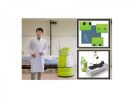(Press-News.org) Scientists at the University of California, San Diego and the Massachusetts Institute of Technology (MIT) have described a new method for detecting liver cancer metastases in mice. The approach uses over-the-counter probiotics genetically programmed to produce signals easily detectable in urine when liver cancer metastases are present. The results of the new study, published in the May 27 issue of Science Translational Medicine, indicate that genetically-programmed probiotics may be useful for detecting liver cancer metastases early-on in the progression of the disease.
Liver cancer metastases are difficult to detect with conventional imaging, and new methods are needed that can detect the metastases in a timely matter. The metastatic spread of cancer is ultimately responsible for 90 percent of all cancer-related deaths, and liver metastases are particularly challenging for clinicians due in part to their small size and multiplicity. If metastases are detected early, patients have a much higher chance of survival.
By using probiotics as a platform for early detection of liver metastases in mice, the researchers took advantage of the fact that certain bacteria are able to pass from the gastrointestinal tract directly into the liver - and the fact that certain bacteria are drawn to tumors.
Over the last 100 years or so, scientists have become increasingly aware of bacteria in environments previously thought to be sterile, such as tumors, indicating that bacteria are part of normal human physiology.
"It was discovered in the early 1900s that certain bacteria selectively colonize tumors," said Arthur Prindle, one of two first-authors on the study, who performed this research as a bioengineering Ph.D. student at UC San Diego. "No one knows for sure, but this could be due to the lack of immune surveillance and availability of nutrients inside the tumor - the bacteria can grow freely without the interference of the immune system."
Armed with this knowledge, the researchers set out to develop a simple method for detecting liver metastases using a mouse model for liver cancer and the probiotic bacterium E. coli Nissle 1917 (EcN). First, they needed to test the idea that a probiotic taken orally would colonize metastases, something that was only previously demonstrated when bacteria were injected directly into the bloodstream.
"EcN is a safe and widely used probiotic," said Prindle. "In fact, we were able to order it from Amazon and engineer it to express the genes we wanted. Next, we needed to see how it would behave in our mouse model."
This meant shipping off their probiotic to the study's other first author, Tal Danino and senior author and MIT professor Sangeeta Bhatia from the Koch Institute for Integrative Cancer Research at MIT. When Danino received the bacteria, the cells had been engineered by the team at UC San Diego to contain a circular piece of DNA called a plasmid, which expressed a gene that caused the bacteria to generate a luminescent signal from the bacterium's natural production of enzymes.
"Because the bacteria were giving off light, we were able to see that they were localizing to the metastases as we had hoped," said Danino, who earned his Ph.D. in bioengineering at UC San Diego before moving on to MIT. "However, the signal is difficult to detect inside a mouse, and even more so within a human. We needed to come up with another way the bacteria could report the presence of a tumor."
To do that, the group engineered the bacteria to overexpress a LacZ reporter.
LacZ is a gene that encodes the protein beta-galactosidase, an enzyme that causes bacteria to appear blue when grown on a medium that contains its substrate. When inside an animal, the product of the enzymatic activity is excreted in urine and causes it to change color; if liver metastases were present, the urine of the mice turned red.
The researchers also added gene cassettes that would ensure the bacteria that colonized the tumor contained their plasmid - one such set of genes contained a toxin that would kill the bacteria if they mutated so as to lose the plasmid. Another caused the plasmid to move to opposite ends of the bacterial cell during DNA replication, which ensured that each daughter cell would receive a copy.
Possible impact
UC San Diego bioengineering and biological sciences professor and the other senior author on the work, Jeff Hasty, expects the new method will enable the detection of liver cancer at an earlier stage, increasing the chances that it will be treated successfully.
"There are multiple reasons to use probiotics in the early detection of cancer," said Hasty. "First, probiotic bacteria are susceptible to antibiotics, which enables their rapid removal from a patient's system once they've done their job. Second, probiotics will do what they do best - grow. That means that patients only need to be given enough probiotic bacteria to ensure that one bacterium arrives at its target location."
The study followed these mice for over a year after oral delivery and found no deleterious health effects.
For background on this project, view this video presentation.
INFORMATION:
Citation
T. Danino, A. Prindle, G.A. Kwong, M. Skalak, H. Li, K. Allen, J. Hasty, S.N. Bhatia, Programmable probiotics for detection of cancer in urine. Sci. Transl. Med. 7, 289ra84 (2015).
Funding
This work was supported in part by the Ludwig Center for Molecular Oncology at MIT, an Amar G. Bose Research Grant, The San Diego Center for Systems Biology (NIH grant P50 GM085764), the National Institutes of Health and General Medicine (R01GM69811), the Koch Institute Support (core) grant P30-CA14051 from the National Cancer Institute, and a Core Center Grant P30-ES002109 from the National Institute of Environmental Health Sciences. This work was additionally supported by Misrock and National Research Service Awards Postdoctoral Fellowships (T.D.), National Defense Science and Engineering Graduate Fellowship (A.P.), and Career Award at the Scientific Interface from the Burroughs Wellcome Fund (G.A.K.). S.N.B. is a Howard Hughes Medical Institute investigator.
A rigorous analysis of more than 3,000 antimalarials purchased in Enugu, Nigeria found 9.3% to be of poor quality, according to new research published in PLOS ONE.
Researchers found 1.2% of the samples to be falsified and 1.3% to be degraded, but raised bigger concerns about 6.8% being of substandard manufacture, leaving patients at risk of not receiving the correct treatment dose and potentially contributing to the development of resistance to the main drug used to treat malaria.
The drug quality team of the Artemisinin-based Combination Therapy (ACT) Consortium ...
PITTSBURGH, May 27, 2015 - Cuts in federal support and unreliable funding streams are creating a hostile work environment for scientists, jeopardizing the future of research efforts and ultimately clinical medicine, according to leaders of the nation's top academic medical centers in today's online issue of Science Translational Medicine.
Led by Arthur S. Levine, M.D., the University of Pittsburgh senior vice chancellor for the health sciences and John and Gertrude Petersen Dean of Medicine, medical school deans from 18 institutions reviewed the financial challenges ...
CAMBRIDGE, MA -- Engineers at MIT and the University of California at San Diego (UCSD) have devised a new way to detect cancer that has spread to the liver, by enlisting help from probiotics -- beneficial bacteria similar to those found in yogurt.
Many types of cancer, including colon and pancreatic, tend to metastasize to the liver. The earlier doctors can find these tumors, the more likely that they can successfully treat them.
"There are interventions, like local surgery or local ablation, that physicians can perform if the spread of disease in the liver is confined, ...
Given the aging of the population and the low birthrate both in Japan and elsewhere, healthcare professionals are in short supply and unevenly distributed, giving rise to a need for alternatives to humans for performing simple tasks. Although increasing numbers of medical institutions have introduced electronic medical records, a variety of issues remain unresolved, such as the inconvenience of data recording and the high costs associated with data input.
The use of robots to support medical care data management and the delivery of resources at the medical front--thus ...
A breakthrough in machine learning has also brought about a "game changer" for the science of metabolomics - and will hasten the development of diagnostic and predictive tests for Alzheimer's, cancer, diabetes and numerous other conditions, leading to improved prevention and treatment.
University of Alberta computing science PhD graduate Siamak Ravanbakhsh published his research in the scientific journal PLOS ONE on an automated process that increases the speed and accuracy of producing a person's metabolic profile from a sample of biofluid such as blood serum or cerebrospinal ...
A major international randomized clinical trial has found that HIV-infected individuals have a considerably lower risk of developing AIDS or other serious illnesses if they start taking antiretroviral drugs sooner, when their CD4+ T-cell count--a key measure of immune system health--is higher, instead of waiting until the CD4+ cell count drops to lower levels. Together with data from previous studies showing that antiretroviral treatment reduced the risk of HIV transmission to uninfected sexual partners, these findings support offering treatment to everyone with HIV.
The ...
(Boston)--Reductions in federal support and clinical revenue not only jeopardize biomedical research at academic medical centers, but may ultimately impact clinical medicine according to an opinion piece in the journal Science Translational Medicine.
Biomedical research is crucial to the US national agenda and academic medical centers--the provenance for much of this research - are at particular risk, according to the authors. Persistent constraints on federal funding threaten to undermine this, and decreasing clinical revenue due to increasingly constrained reimbursement ...
(SACRAMENTO, Calif.) -- Do microbes grow differently on the International Space Station than they do on Earth? Results from the growth of microbes collected by citizen scientists in Project MERCCURI indicate that most behave similarly in both places.
"While this data is extremely preliminary, it is potentially encouraging for long-term manned spaceflight," said David Coil, Ppoject scientist in the microbiology lab of Jonathan Eisen at the University of California, Davis.
"With this part of Project MERCCURI we hoped to shed light on how microbes associated with the normal, ...
From AGU's blogs: Should NASA be Studying the Earth?
Joseph R. Dwyer, a Professor at the Department of Physics and the Space Science Center in the Institute for the Study of Earth, Oceans, and Space at the University of New Hampshire, shares his thoughts about whether NASA should be studying the Earth in a blog post on The Bridge.
From Eos.org: Musical Composition Conveys Climate Change Data
A student at the University of Minnesota communicates climate change science in an innovative way.
From AGU's journals: Dynamics of the Earth's Surface in the Eastern Tibetan ...
When you're blasting though space at more than 98 percent of the speed of light, you may need driver's insurance. Astronomers have discovered for the first time a rear-end collision between two high-speed knots of ejected matter. This discovery was made while piecing together a time-lapse movie of a plasma jet blasted from a supermassive black hole inside a galaxy located 260 million light-years from earth.
The finding offers new insights into the behavior of "light saber-like" jets that are so energized that they appear to zoom out of black hole at speeds several times ...

